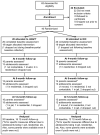The efficacy of two adolescent substance abuse treatments and the impact of comorbid depression: results of a small randomized controlled trial
- PMID: 25799306
- PMCID: PMC5021542
- DOI: 10.1037/prj0000106
The efficacy of two adolescent substance abuse treatments and the impact of comorbid depression: results of a small randomized controlled trial
Abstract
Objective: The purpose of this randomized trial was to investigate the efficacy of 2 behavioral treatments focusing on different change mechanisms in ameliorating a borderline personality disorder constellation of behaviors and substance use in adolescents referred by juvenile diversion programs.
Methods: Forty adolescents 14-17 years of age and meeting Diagnostic and Statistical Manual of Mental Disorders (4th ed.) criteria for borderline personality disorder and substance use disorders were randomized to integrative borderline personality disorder-oriented adolescent family therapy (I-BAFT) or individual drug counseling. This design allowed a comparison of 2 manualized interventions, 1 family based and 1 individually oriented. Profiles of clinical change were used to detect impact and estimate treatment effect sizes.
Results: Primary analyses showed that both interventions had a clinically significant impact on borderline personality disorder behaviors 12 months after baseline but with no differential treatment effects. The impact on substance use was more complex. Subgroup analyses revealed that adolescents with depression had significantly more severe profiles of borderline personality disorder and substance use. These youths were the only group to show reductions in substance use, but they only did so if they received the I-BAFT intervention. Study data also documented the high dosage of intensive residential treatment needed by this population.
Conclusions and implications for practice: Results highlight the intensive treatment needs of juvenile justice-involved youths with co-occurring substance use and borderline personality disorder including depression, the hybrid outpatient and residential treatment often required by this population, and the promise of a family-oriented approach, particularly for youths with severe symptoms and co-occurring depression. (PsycINFO Database Record
(c) 2015 APA, all rights reserved).
Figures




References
-
- Bernstein DP. Adolescent personality disorders: Just a passing phase? The Journal of the California Alliance for the Mentally Ill. 1997;8:56–57.
-
- Brook JS, Brook DW, de la Rosa M, Duque LF, Rodriguez E, Montoya ID, Whiteman M. Pathways to marijuana use among adolescents: Cultural/ecological, family, peer, and personality influences. Journal of the American Academy of Child and Adolescent Psychiatry. 1998;37(7):759–766. - PubMed
-
- Chanen AM, Jackson HJ, McCutcheon LK, Jovev M, Dudgeon P, Yuen H, … McGorry PD. Early intervention for adolescents with borderline personality disorder using cognitive analytic therapy: Randomized controlled trial. British Journal of Psychiatry. 2008;193(6):477–484. doi: 10.1192/bjp.bp.107.048934. - DOI - PubMed
-
- Cornelius JR, Bukstein OG, Salloum IM, Kelly TM, Wood DS, Clark DB. Fluoxetine in depressed AUD adolescents: A 1-year follow-up evaluation. Journal of Child and Adolescent Psychopharmacology. 2004;14:33–38. - PubMed
Publication types
MeSH terms
Grants and funding
LinkOut - more resources
Full Text Sources
Other Literature Sources
Medical

